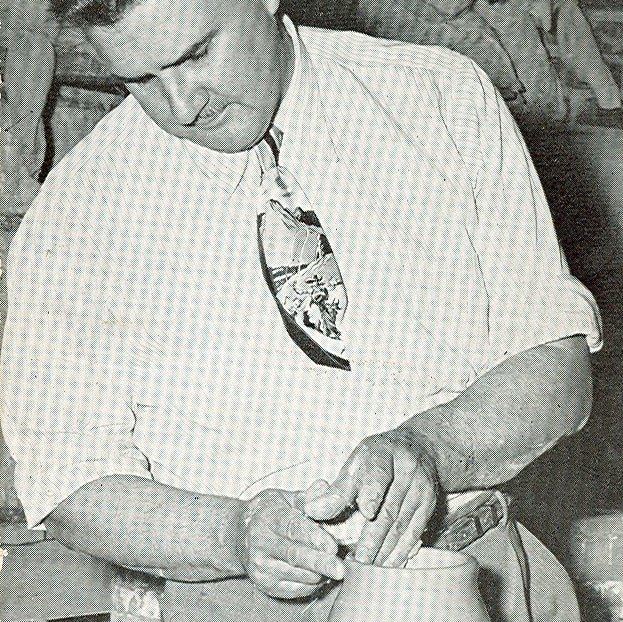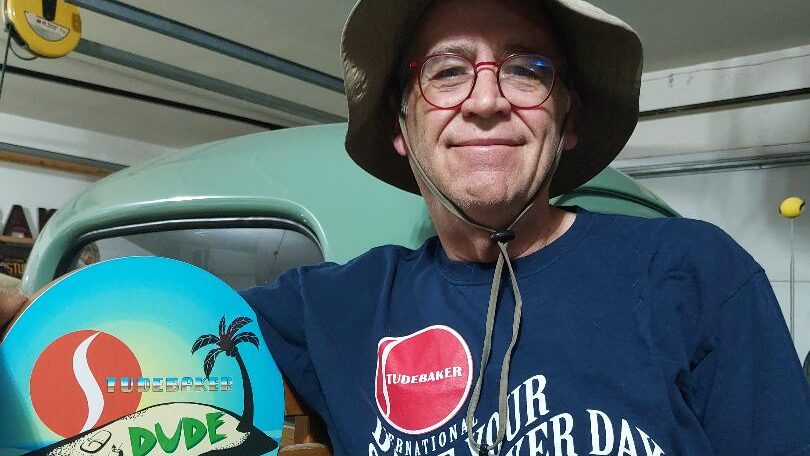After graduating from the Chicago Art Institute, John Frank took a position as a ceramics professor at the University of Oklahoma in 1927. While at OU, he spoke to some Geology professors about uses for the high-quality clay in the area.
Frank saw in the clay of Oklahoma, a color and composition that had the potential for creating a unique form of pottery. Frank imagined pottery that represented the beauty and rich colors of the Southwest.
John Frank, and his wife Grace, equipped with one small kiln and some rudimentary equipment, started a studio in their home. In 1933, they opened a small studio in Norman, Oklahoma, and named it “Frank Potteries.” Using the cream-colored clay from the Arbuckle Mountains, they began selling their pottery as a part-time enterprise.
Frank resigned his position at OU in 1936. At the suggestion of his wife Grace Lee, he renamed the business “Frankoma Potteries.” This portmanteau was derived from Frank’s last name, and the last three letters of “Oklahoma.” Frankoma Potteries was producing the only commercial pottery in Oklahoma. The Franks strived to produce quality, affordable, uniquely beautiful pottery. However, the pottery was not well-received and they struggled through the Depression years.

John Frank demonstrating Potter’s wheel. Photo courtesy of Sapulpa Historical Society.
At the behest of the Sapulpa Chamber of Commerce, they moved their factory to Sapulpa, Oklahoma. The plant, named “Frankoma Pottery” was constructed in the northwest section of Sapulpa on land provided by the Chamber. The Franks continued to haul clay in from Ada, which took three days. In 1954, after digging a sample from iconic Sugar Loaf Hill,
Frank decided to use the local clay. The clay from Sugar Loaf was rich in iron oxide, thereby giving the clay a red, instead of a cream, color. This move defined Frankoma’s unique look and texture that imitated an aged terracotta look.

Native American art and colors of the Southwest were the inspiration for their designs. Most of the colors represented the colors of the Prairie: greens, tans, and sand. The green was not the ‘Matte” green used in other American art pottery during that era. The glazes had names like Prairie Green, Desert Gold, Sky Blue, Autumn Yellow, Black, Brown Satin, Flame, Redbud; Peach Glow, Robin Egg Blue, White Sand, and Woodland Moss.
Frank used a unique manufacturing process in which the clay body and colored glaze was fused and fired. Frank also experimented with a mineral called rutile, which contained titanium dioxide, which allowed the color of the clay to partially show through the glaze. This process was highly efficient and made Frankoma Pottery more affordable than the competition.
As an elementary school student, I remember going on a field trip through the Frankoma Pottery factory. Mr. Frank explained every step of the process and mentioned he had patents on the method. This tour inspired me to take some clay from Sugar Loaf and “sun bake” my own crude pottery attempts.

Since it was located on Route 66, tourists stopped and bought pottery as gifts and souvenirs. The business grew and became quite prosperous, allowing the Franks to commision Bruce Goff, a world- acclaimed architect, of whom Frank Lloyd Wright said was one of the few “creative architects in America,” to design their “dream” house. The house was built utilizing ceramic brick and tile that John and Grace Frank designed and created. I was in the home about 15 years ago, when one of the daughters, Joniece Frank, lived there. The house was simply stunning and was filled with Frankoma Pottery and art her parents had collected. I remember Joniece quipping that the only downside to the house was that it was not energy-efficient and was expensive to heat and cool. The house is currently on the National Registry of Historic Places.
John Frank died in 1973, leaving the business to one of his daughters, Joniece. The factory caught fire in the early 1980s,and rebuilding started in 1983.
Then, the business was purchased by an out-of-state investor and the business stayed open until 2004. In 2005, Det and Crystal Merryman purchases the factory and had planned to streamline the manufacturing process and cut waste. He sold the business in 2008 to Joe Ragosta, who closed the business in 2010. Frankoma Pottery was put on the auction block in 2011. The 1800 original molds, the Frankoma name, and the real estate were not auctioned off.
Thus, another chapter in the history of Sapulpa art, and entrepreneurship came to an end. Frankoma put Sapulpa on the map and was sold world-wide. Collectors for as far away as Hong Kong cherish their Frankoma.
My parents bought pottery for the home and for gifts. My mother commissioned Grace Lee Frank to create a personalized wedding plate when my late wife and I married in 1973. Sadly, the plate fell off a plate rack and was destroyed. We shopped there until the early 2000s, buying pottery as gifts for my sister in Texas.
Frankoma Pottery remains collectible and highly sought after. Limited editions and Southwestern theme ware is increasingly becoming popular among collectors. There were many speciality-themed-items, such as political mugs,ceramic Christmas cards, special edition plates made for ORU, as well as SouthWestern-themed salt and pepper shakers, plaques, and a plethora of products which remain popular to this day.









